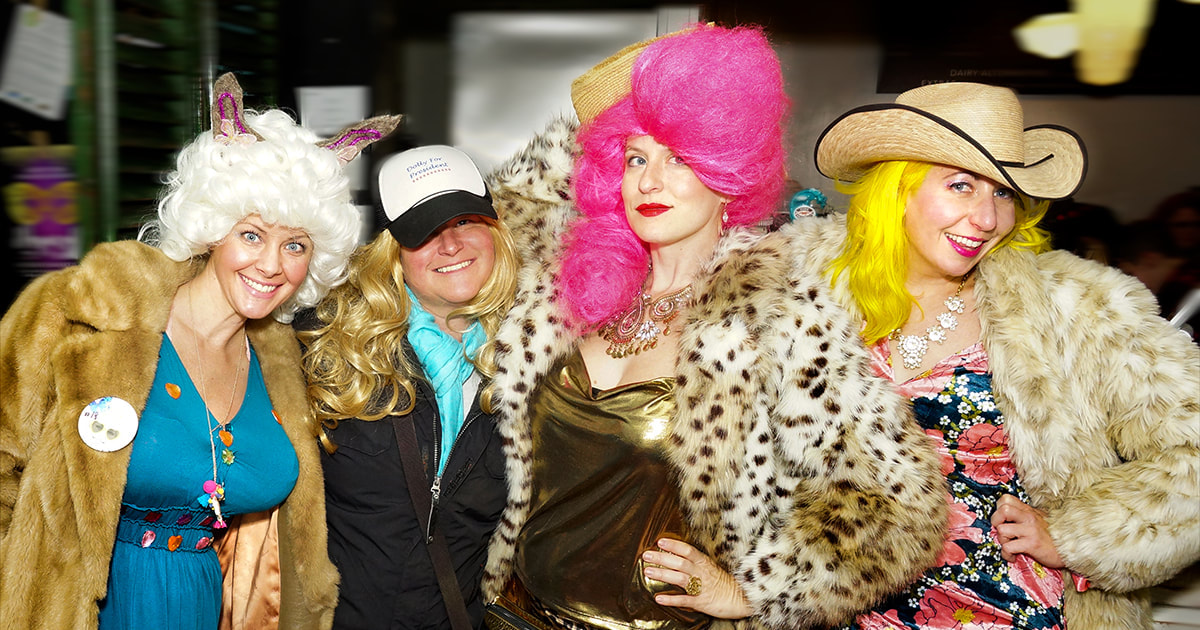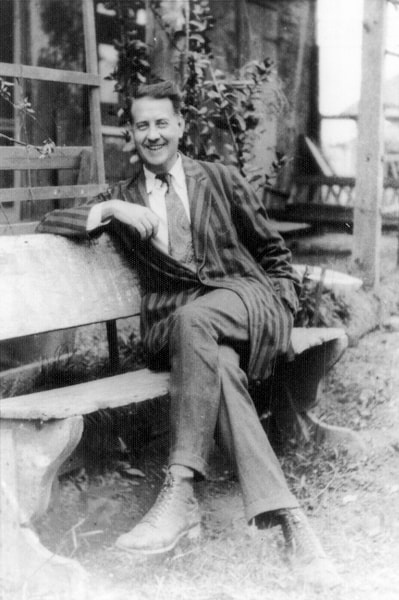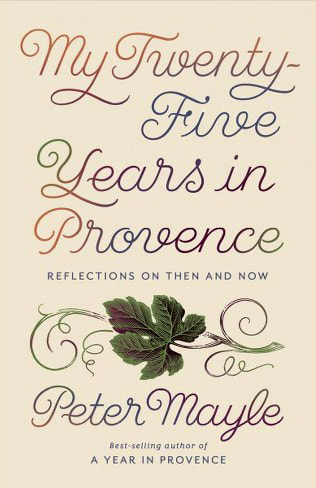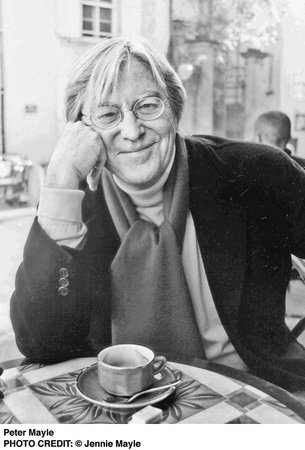Richmond Barthé left Bay St. Louis at age fourteen. He became one of 20th century America’s greatest sculptors of the human form - and Mississippi’s preeminent artist in the field.
- story by Edward Gibson
According to Celestine Labat, in the oral history preserved by Lori Gordon, Barthé was pronounced like “hearth.” His mother, the Creole Clemente’ Rabateau, hailed from a family of craftsmen, and his father, Richmond Barthé, an “American” as the Creoles disparaged, was a dark-skinned, grey-eyed African-American. The elder Richmond died within months of Jimmy’s birth.
Jimmy enrolled at the newly formed St. Rose school where he met Celestine Labat’s sister, Inez Labat. The teacher Labat recognized Jimmy’s talent for drawing and encouraged him with both praise and a supply of pencils and paper. Inez Labat encouraged the young artist throughout his life. Jimmy’s talent for portraiture soon drew the attention of the town, and the Pond family from New Orleans hired the young boy to work at their summer home. In the early twentieth century, African Americans could go only so far in school and when Jimmy completed the eighth grade, he moved with the Pond family to New Orleans. Through the Ponds, Jimmy met Lyle Saxon, editor of the Times-Picayune, and future biographer of Jean Lafitte. Saxon, hardly ten years Jimmy’s senior, purchased Jimmy’s first oils and canvas. Barthé’s biographer, Margaret Rose Vendryes, in “Barthé: A Life in Sculpture,” hypothesizes that the two shared an intimate relationship, though there is no certain evidence to support this. Saxon sent Jimmy on false errands to Delgado where he could view the school’s classical art collection, a collection not generally available to people of color. At twenty-three, Jimmy Barthé rendered a portrait of the Savior for a church bazaar which impressed Saxon. He attempted to have Jimmy enrolled in Delgado College - without success. Undeterred, and with the assistance of the local parish, Jimmy Barthé applied to the Pennsylvania Academy of Fine Arts and the Art Institute of Chicago. Chicago accepted him. Had Barthé attended the Pennsylvania school, he would have matriculated with Walter Anderson. With a modest fellowship from the parish in New Orleans, Barthé took up residence in the home of his Aunt Rose in the Bronzeville neighborhood on the South Side of Chicago. He attended night classes at the Art Institute and turned his attention to sculpture by accident. He was facing difficulties capturing the third dimension in his painting and an instructor suggested sculpting in clay. Classmates sat as models and Barthé created two busts. The transformation was complete. He was no longer Jimmy Barthé but Richmond Barthé (pronounced “bar-tay”). In 1927, Richmond Barthé exhibited in a show called The Negro in Art Week. Critics panned the show, but praised the success of Richmond’s two busts, and he drew the attention of Chicago’s philanthropists, notably Julian Rosenwald. With their encouragement, Richmond established a studio in Bronzeville and created the first of many opuses, among them “Tortured Negro” (1929) and “Black Narcissus" (1927). The former was modeled on the classical pose of St. Sebastian, who was tied to a tree/post and pierced with many arrows. The piece has been lost, according to Vendryes: “dimensions and location unknown.”
Inez Labat visited the Bronzeville studio in 1929. According the Celestine, Inez found Richmond Barthé eating canned beans and the “soles of his shoes were flapping.” Labat took the impoverished young Barthé to a cobbler and “gave him some change.” In gratitude Richmond sculpted Inez Labat, “La Mulatresse” (1929), in plaster and gave it to her.
That year Richmond Barthé received the first of two Rosenwald fellowships. With this money and funds he received from a successful one-man show, Richmond Barthé moved to New York City and into the heart of the thriving Harlem Renaissance. There, he met African American luminaries such as Langston Hughes, James Weldon Johnson, Alaine Locke and Ralph Ellison. In New York, he became simply Barthé. Over the next twenty years, from studios in Harlem and in Greenwich Village, Barthé created his body of work and enjoyed success that the Jimmy Barthé could have only imagined. Barthé sold pieces to the Whitney and the Museum of Modern Art as well as to wealthy collectors. He crafted “Blackberry Woman” (1930), his first major piece after moving to New York.
In 1935, Barthé exhibited at the Rockefeller Center alongside Matisse and Picasso. His sculptures, including “Feral Benga” (1935), “African Dancer” (1933), and “Wetta“ (1934), received more praise from critics than his more well-known contemporaries. Also in 1935, Barthé crafted his most political work to date. “The Mother” depicted a women holding the lifeless body of her son, the noose still hung about his neck. Sadly, Barthé, never comfortable as a dissident, later destroyed the piece. Barthé installed several public commissions, including a frieze in Harlem, “Exodus and Dance” (1940) and works for the James Weldon Thomas House. Dance and the music of the Savoy Club inspired much of his work, including “Rugcutters” (1930) and “Kolombwan” (1934). He also crafted several religious pieces, including a life-size statue of the Savior, “Come Unto Me“ (1947), commissioned by the St. Jude School in Montgomery, Alabama. In New York, Barthé also felt less confined in his sexuality. He crafted the homoerotic pieces “The Stevedore” (1937) and “Boy With a Flute” (1939). For reasons unclear, Barthé abandoned New York in 1949. He traveled with the wife of philanthropist Robert Lehman to her winter home in Jamaica, and shortly afterwards, he purchased an estate there, Iolaus. His time in Jamaica was unproductive. He tried to paint without success. He completed his two largest pieces, “Toussaint L’Ouvreture" (1952) and the equestrian “Dessaline" (1954), for the Haitian government’s sesquicentennial celebration, but he accomplished little else during his time in Jamaica. Iolaus was without power or telephone and his expatriate neighbors fled the hot and rainy summers. Loneliness and the slow pace of island life exacerbated an underlying depression. In 1961, he entered a hospital, first in Jamaica and then later in New York’s infamous Bellevue Hospital. Doctors diagnosed him with schizophrenia and he received shock treatment. He recovered enough to return to Jamaica but sold Iolaus in 1964. Unsure of where to turn, Barthé came home briefly, visiting his old teacher, Inez Labat. He received the keys to the city from then-Mayor Scafidi. Barthé spent several years in Florence, Italy, in the shadows of the Renaissance masters who had inspired his life’s work. Perhaps overwhelmed by the magnitude of Michelangelo, he could not work. He again became sick, and after a convalescence with friends in Lyon, France, arranged for return passage to the states. Penniless and ill, Barthé landed in Pasadena, California. He became the benefactor of patrons such as James Garner and Bill Cosby, although he ultimately sued the latter for casting statues without his permission. The City of Pasadena recognized the national treasure, and a street there is named for him. In the final photograph of the Vendryes biography, Barthé holds the street sign bearing his name. He smiles. Barthé died March 6, 1989, from complications related to cancer. St. Rose conducted a celebratory Mass and the bells rang in his honor. Barthés artistic legacy is complicated. Many African Americans disparage him as an “Uncle Tom,” for his many busts of famous men, including his last known piece, a bust of his patron, James Garner. He destroyed his most overtly political piece The Mother and may very well have destroyed Tortured Negro. He declined to permit the former to be displayed in the 1934 show, An Art Commentary on Lynching. The Creole Barthé was too high-minded, too formal for overtly political artists, such as Marcus Garvey. His formalism also set him apart from other modern sculptors. His work was too representational, too linked to the Renaissance to fit neatly among moderns such as Henry Moore and Alberto Giacometti. His harshest critics simply decry Barthé as an imitator, notable only for rising above the oppressive racism of his times. Vendryes, however, rightly notes that a Creole homosexual sculpting nude Africans and African-American models overtly challenged a white audience so fearful of African-American virility that they would (and often did) resort to violence to suppress it. Where Walter Anderson’s muse was the natural world and Ohr’s musen was pure form itself, Barthé reveled in the human body. He was not, as detractors argue, an apologist for whites in the separatist country of his birth. He longed for integration and advocated for it. However, politics was not his medium. It was the dancer, boxer, worker and the dying man. He treated them with dignity. Barthé, the artist said, “black is a color, not a race.” There is little remaining in Bay St. Louis to memorialize our greatest artist. A large pre-Katrina mural paying homage to the great artist was painted on the side of a county office building (on the corner of Second and Main Street), but the building was damaged by the storm and later demolished. The Bay St. Louis library houses a bust he gave to the city in 1964. Celestine Labat mentions a street off of Bookter named in his honor, but there is no Barthé or Barthe street found on the county’s Geoportal. Celestine Labat tells a story in Lori Gordon’s oral history. It is unclear when, but according to her, “Jimmy” Barthé was visiting one year at Christmas. A reveler came, and deep into his cups, the drunk man dropped and broke the plaster bust of Barthés first benefactor, Inez Labat. According to Labat, “We heard a crash from the parlor, and Barthé didn’t say anything, he just put his head in hands.” Years later, Celestine came into some money, and she sent Barthé the shards. He cast the piece, "La Mulatresse," in bronze and sent it to her, recouping only material costs and the foundry’s bill. Sources Vendryes, Margaret Rose, Barthé: A Life in Sculpture. University Press, 2008. Gordon, Lori K. “Oral History of Celestine Labat” Univ. of Southern Mississippi Oral History Project, 2003. Vertical Files, Hancock County Historical Society. Various Articles, Sun-Herald Archive. The Amistad Project. Tulane University.
Janice Hall brings a wealth of wine knowledge and a taste of Sonoma to this cozy Central Avenue eatery.
- story by Lisa Monti
“I draw upon my experience as a Master Commander Emeritus with the International Brotherhood of the Knights of the Vine for wine choices/selections,” Janice says. KOV is the oldest wine society in the country and is an off-shoot of the over-300 year-old European wine society. To make the most of all that good wine, Central Station Bistro also serves an outstanding selection of gourmet cheeses and charcuteries to round out a visit to the bistro, where every board is made fresh upon order. Prepping the meats and cheeses - all sliced to order - guarantees freshness and that naturally takes time. The result is “worth the wait,” Janice promises. And since Janice is a professional photographer, it’s no surprise that the Bistro’s boards make for gorgeous presentations. Combinations of cheeses with plump grapes, salty almonds, fresh berries, toast, baguette slices and swirls of prosciutto arrive ready for their closeup. “It’s all about the drama,” Janice says. Janice works with a supplier who specializes in domestic and imported foods to make sure the meats, cheeses and pates are always “top of the line.” Customers know that their favorites will be available and prepared fresh every time. The boards provide a variety of tastes and textures. The jams are from a North Georgia farm. The crisp baguettes are served hot out of the oven with rich Irish butter. The pickles, pickled asparagus and artichoke hearts add an element of tartness. Janice’s interest in cooking and talent for entertaining guests eventually led to the Bistro. She and her husband Jim lived in California before moving here and when they found a spot for their new endeavor, Janice easily segued from seasoned hostess to the Bistro. The boards come in a variety of elements, giving wine (and beer) drinkers a sampling or something more substantial. The simple sampler comes with one meat, a cheese, dried fruit and nuts served with crackers. From there, the board offerings multiply. The Fromage board has three artisan cheeses along with fresh fruit, preserves and baguette. The Charcuterie board has three meats served with cornichons, olives, stone ground mustard, dried fruit and baguette. The Fromage et Charcuterie combines the best of both. With the three meat/three cheese board, Janice says, “I challenge anyone to leave hungry.” The Sweet Board serves to satisfy cravings with truffles, biscotti and seasonal fruit, all drizzled with chocolate by Ghiradelli. Janice notes, “The truffles are provided by the oldest chocolate maker in New England, specifically Rhode Island. Both the preserves and truffles are available to purchase under the Central Station Bistro name.” Fans of crostini will find two standards on the menu including the always popular Bruschetta (chopped tomato, garlic, Balsamic vinegar topped with Parmesan, parsley and mint) served with stuffed olives. The other is half a baguette stuffed with Brie and Proscuitto and baked. “It’s our version of melted cheese,” Janice says. Regular customers at the Bistro know they can count on finding their favorite beverages and boards in a friendly atmosphere and they also enjoy the service provided by what Janice calls her “Dream Team.” Jennifer Black joined the Bistro with ten years experience at The Sycamore House. Pam Valentine, a native Mississippian with a natural talent for interacting with people, has a background in customer service. Rebecca Jaquith Diaz is a caterer who previously owned a kitchen store in Old Town and is “an all around Bay St. Louis favorite,” Janice said. Janice promises great ideas are in the works for the Bistro’s future. Central Station Bistro 205 Central Ave. Bay Saint Louis, MS 39520 (228) 342-5832 Open Thursday through Saturday 5-9 p.m.
Americans love our dogs, but their poo? It's the cause of neighborhood fights, city ordinances and health issues. A veteran dog owner writes about her own clean-up conversion.
- story by Denise Jacobs
Editor's note: for artwork with this story, we've included some of the more humorous pick-up reminder signs we found during an Internet search.
A 2006 study published in the Journal of Applied Psychology found that owners pick-up after their dogs slightly more than 60 percent of the time. But this study is based on self-reporting and you know about the human tendency to exaggerate.
Why don’t some people pick up after their dog? Bags - people forget to carry poo bags; some people can’t see at night; some people don’t like to carry around a bag of poo; some of us can’t bend down easily. Some of us mistakenly think that excrement breaks down quickly and is absorbed by the earth; and for some of us - runners in particular - it’s a matter of stopping (or not stopping). Regardless, the people at Cuteness.com say, no matter what the reason, “the poop must be scooped.” In fact, a little internet research reveals a work-around for all the issues listed above, including the obvious (like bag dispensers that attach to a dog’s leash and flashlights, for example).
My friend David thinks people who don’t pick up after their dogs deserve to step in dog poop as a kind of karmic justice. I remind David that he once sat in a pile of dog poo at my mother’s farm long before he even owned a dog. Karma had little to do with David’s plop down on the grass, without so much as a look around.
It was more a consequence of country living. Back in the day, if you owned 350 acres and raised cattle, you weren’t inclined to pick up after your dog. Truth be told, David should be happy it was dog doo and not a cow pie. A colleague once complained to me about the many dog owners who failed to pick up after their dogs and the subsequent stinky piles deposited on her well-cared-for lawn. I casually remarked that I was among the guilty. While I did not live in my colleague’s neighborhood, I did not pick up after the 62-pound pit/chow I inherited post-Katrina. By the way, according to the Pet Poo Skiddoo Dog Waste Calculator, at 62 pounds, my dog had the potential to produce a hefty 424.31 pounds of poop a year. The bigger the animal, the more prodigious the output.
Based on my colleague’s horrified reaction, an explanation seemed in order. I said, “You must understand that dogs are forever pooping on my lawn, too, and their owners don’t pick up after them.”
I wanted my colleague to understand that I was a victim of sorts. I, too, had been shat upon. I wanted her to see the logic in my argument, even the karma of my actions, if you will. Alas, it was not to be. My highly-rational colleague countered my faulty logic by practically blurting out her response: “But, Denise! They’re not my dogs! I don’t even own a dog!” Ah! Logic. And thus began my awakening.
Now, all these years later — another city, another dog — I really wish dog owners would pick up after their pets. When they don’t, all dog owners get a bad rap. Mothers whose children have run barefoot through dog doo scream at us indiscriminately. We get chased out of parks. People at outside cafés cast suspicious looks our way.
But this is all secondary to the real issue of dog waste, which supersedes stigma and stench and has more to do with health and sanitation. Dog waste carries the potential for disease. 
Foster and Smith, a vet-owned pet care company, lists five important reasons to clean up after your dog, and chief among them is disease control. A quick Google search of companies specializing in the removal of dog waste (Doody Calls or Dr. Dog Poop, for example) reveals that pet waste is an environmental pollutant. Dog feces can carry a host of bacteria and parasites, including whipworms, hookworms, roundworms, tapeworms, and giardiasis.
And did you know that simply walking in a fecal-contaminated yard with shoes on and then wearing those shoes into your house has the potential to create infection in humans?
If that isn’t enough, be aware that many cities have pooper-scooper laws in place. In Bay St. Louis, for example, neighborhood signs indicate a hefty fine associated with failure to pick up after Fido.
Remember, picking up after your dog is not about the weather; dog doo has a longer shelf life than you might expect, rain or not. It isn’t about karma, which sometimes flies in the face of logic, at least as we mortals understand it. And it’s not about whether anyone can see us. Remember the John Wooden quote? “The true test of a man’s character is what he does when no one is watching.” It isn’t even about the fines! It is about responsible dog ownership and doing the right thing, not 60 percent of the time, but all the time. Note to self: just do it!
Former U.S. Ambassador and survivor of the 1998 embassy bombing in Kenya, Prudence Bushnell, tells that story in her gripping new book, "Terrorism, Betrayal and Resilience." With the emphasis on resilience.
- by Rheta Grimsley Johnson
Pru Bushnell will be speaking and signing her book at Pass Books (300 E. Scenic Drive, Pass Christian) from 5:30pm till 6:30pm, on Tuesday, January 29.
At noon on January 31 she will speak to a joint meeting of Gulfport’s Kiwanis and Rotary clubs.
In 1998, Pru was American ambassador to Kenya when the embassy in Nairobi was bombed by the radical Islamist group al-Qaeda – back before most of us had heard of al-Qaeda.
She did not die. Pru lived to tell her firsthand story of the bombing, its 213 fatalities and 5,000 casualties. A story that never inspired congressional hearings and is largely forgotten except by those who were there.
And in telling that story from a hard-hitting, non-partisan perspective, she illuminates flawed characters, policies and agencies. For it isn’t always a flattering portrayal of the national security community or politicians. Her exchanges with Susan Rice, Madeleine Albright, Bill Clinton and other “name” public servants sometimes make you wince. This is a minefield of what-ifs. Pru grew up in exotic places and largely patriarchal cultures, everywhere from Paris to Pakistan. Her father was in the foreign service, her mother the perfect foreign service wife, not an easy job that included, in post-war Germany, hosting orphans and helping widows.
But the men were in charge.
“As a girl growing up in the 1950s, it was inconceivable that I could become a leader, much less one who excelled in disasters,” Pru writes. “My only role model was Joan of Arc, and I was well aware of what happened to her when she put on a pair of pants and led men.” So it surprises no one more than Pru what a continuous adventure her life has been, a serial of true and turbulent stories that make a mockery of Hollywood and its “Homeland”-style heroines. From her first assignment in Dakar, Senegal, she has worn the pants and embraced the leadership role fate assigned her.
Before the embassy bombing in Kenya, Pru worked in Washington in the State Department’s Africa Bureau during the Rwandan genocide that slaughtered 800,000 people. “We were doing nothing to stop the killing, so I took it upon myself to call Rwandan military figures perpetrating the genocide to let them know we were watching and to advise that they would be held personally accountable for their deeds,” she writes. That episode of her life would be depicted in a movie, “Sometimes in April,” in which Pru is played by actress Debra Winger. The cover of her new book – Pru is walking away after laying a wreath at the bomb site in Nairobi – is a photograph by John McConnico that won the 1999 Pulitzer Prize for Photojournalism. From Kenya, still suffering with post traumatic stress, Pru became ambassador to Guatemala, hardly a healing place. There she was burned in effigy and watched, from a distance, as the United States was attacked by al-Qadea on September 11, 2001. 
Now retired, in theory only, she crisscrosses the country giving talks about leadership, mostly to women. She lives in Washington with her husband, Richard Buckley, in a home with a view across the Potomac of the Lincoln Memorial.
This visit to the Pass is due to her friendship with former State Department employee and Pass resident Betty Sparkman. The book, published late last year by Potomac Books, an imprint of the University of Nebraska Press, is on sale now at Pass Books.
One of the longest-running syndicated columnists in the country and author of eight books, award-winning writer Rheta Grimsley Johnson divides her time between Pass Christian and Iuka, Mississippi. You'll find her books at Pass Books and other book retailers. Read more about herhere.
A few times a year, the iconic Second Saturday Artwalk event in Old Town Bay St. Louis adopts a theme. Of course, celebrating the arts! For the past four years, Dolly Parton has been the focus during January, the month of the music star's birthday. It's called "Dolly Should," as in Dolly-Should-Come-And-Spend-Her-Birthday-In-Bay-St.-Louis.
The day boasts a bevy of country-themed events with the grand finale being an extraordinary - and VERY competitive - Dolly Look-alike contest. Stay tuned for complete details! Be sure to check out this month's "Hot Spot" businesses: Mezzo Mezzo, 300 South Second Street and Wild Gypsy Boutique, 131 Main Street. Read more about them below in stories by Caroline St. Paul.
Mezzo Mezzo
|
|
|
Mind+Body+Spirit - Jan/Feb 2019
|
- story by Denise Jacobs
|
From 2001 through 2015, I sang with a church choir in Baton Rouge, Louisiana. We rehearsed every Wednesday night.
I’ll let you in on a secret: most of us did not feel like rehearsing. Like so many activities that are good for us, getting out the door was the hardest part. Every Wednesday evening of every week, mid-August through early June, thirty-plus choir members dragged themselves to rehearsal. And most of the time, most of us went home feeling happy that we showed up. |
Mind+Body+Spirit
|
Studies show that singing with other people fosters connections with each other as well as with the environment. Research indicates that singing has key physical benefits. It exercises major muscle groups in the upper body. It’s an aerobic activity that improves the efficiency of our cardiovascular systems and encourages the movement of oxygen into our bodies, leading to increased alertness.
Singing also aids the development of motor control and coordination and even improves neurological functioning. The evidence is so compelling that Daniel Pink has written in When: The Scientific Secrets of Perfect Timing(2018), that “singing in a choir could be the new exercise.”
I sing for the discipline and clarity of focus. For an hour and a half once a week, I don’t think about environmental disasters, politics, my latest project, or my next meal. The music on the page commands my full attention. I concentrate on my voice and the voices around me.
Something magical happens in the act of merging our voices into one beautiful sound, a sound uninfluenced by political persuasion, ethnicity, or gender. In the music, we are one.
I sing for the intimacy that is created within the sacred space of the music we make. I am as closely attuned to the inhalation of those on my right and my left as I might be a lover. I memorize the strengths of the alto section.
Some of us are great sight readers. Some learn by ear. Some can always be trusted for the right note; others are less trustworthy in this regard. Some of us have a concrete, dependable sense of rhythm. Others, not so much.
The attunement to others that is experienced in choir is akin to what Daniel Pink describes as the profound experience of “synchronizing in time with others.”
Singing together in the context of choir creates such a sense of belonging that, over time, we let our collective guard down. One turns a hymn into boogie-woogie. Two others improvise chorus line choreography. A few can’t resist a hearty extended “Ah-men,” a telling throwback to an earlier religious experience.
When my sister died in 2012, my tears didn’t fully flow until a Wednesday night a few weeks later, when, surrounded by the music of my choir peeps, I found myself weeping uncontrollably, safely, securely enveloped in the sanctuary of communal song.
When we work through a piece of music for the first time, we have, as my long-standing choir director put it, “differing opinions” as to the composer’s intent.
Yet, by the time the choir sings before the congregation, not too many weeks later, those differences have been reconciled, and we have come together in agreement, of one accord, with one voice and one song. And it doesn’t get any better than that.
One of my friends from choir, a bass I sang with for years, put it best. He said, “My wife won’t let me make love with other women, but I can sing with as many women as I’d like.”
|
First I would like to thank the voters of Ward 1 of Waveland for having the confidence in me to elect me for a second term as your alderman. I promise to continue to work diligently for you and represent you to the best of my ability.
The Mayor and Board of Aldermen officially begin our new term this month. The first Mayor and Board of Aldermen meeting will be January 2. |
What's Up, Waveland?
|
The following appointments are made exclusively by the Mayor WITHOUT approval of the Board of Aldermen:
- Fire Chief
- Police Chief
- City Clerk
- City Attorney
- Judge
- Prosecutor
- Public Defender
- Mayor Pro Tem
- Water and Gas System/Utilities Superintendent
The appointment of the three election commissioners is recommended by the Mayor, but MUST BE APPROVED by the Board of Aldermen.
The Hancock County Supervisors pitched in more than $800,000 from GOMESA funds and the remaining is being paid through Tidelands Funds and the seawall gasoline tax. I give a huge thank you to the Hancock County Board of Supervisors for their support for this project.
Waveland will continue to work on the three citywide sewer improvement projects. All of the projects are still on schedule and on budget. Last month, Waveland approved an additional 900 feet of new sewer to Edna Street. The 900-foot addition will allow over a dozen property owners to be removed from the grinder pump system and will also reduce the amount of wastewater Waveland pays to treat.
This project is four years in the making and will vastly improve pedestrian traffic safety. Waveland is using MDOT funding to help pay for the sidewalk project which is the reason this project has moved at a snail’s pace.
During January and February, several board members and I will go to Jackson to speak with lawmakers to request funding for various projects and discuss a number of other issues that affect Waveland.
I look forward at the next four years to bring great opportunity for Waveland.
|
|
Sponsor Spotlight - January 2019
|
-story by Lisa Monti
|
Michael Warner describes his publishing venture, Cultured Oak Press, as “kind of an experiment” that strikes “an unusual chord.” His website features Warner’s writings about art, culture and food along the Mississippi and Louisiana coastlines, with the goal letting the voices of under published writers be heard through blog posts and books.
In Warner’s view, finding good material to publish shouldn’t be a problem in this creative region that is known for its embrace of colorful characters and devotion to good food, family and the past. |
Sponsor Spotlight
|
Warner unexpectedly set out on the path to publishing while putting together a work of his own. “I was working on a project that turned into a book and I thought a good way to approach it would be to set up a publishing company and make it the first project out the door.”

Warner, a native of New Orleans, started working on the anthology back in November 2017.
“A lot had been written by and about Saxon but his early works were largely ignored,” Warner said.
“My mother, Jeanne Warner, knew him quite well. She was a longtime Bay St. Louis resident and she introduced me to him many years ago. I have almost 20 hours of taped interviews with him. His life was just fascinating.”
The research led Warner to Alberta Kinsey, an early French Quarter artist who painted scenes of local courtyards, patios and buildings. “I was researching her life and it turns out she was a close friend of Lyle Saxon,” Warner said.

He then accepted a position in San Francisco, heading legal work at a Pfizer Pharmaceuticals research site. He retired from Pfizer a few years ago and now works as an attorney for a small biotech startup in San Francisco. Warner and his wife, Connie, divide their time among Bay St. Louis, the St. Louis area and San Francisco.
Warner said his choice of The Cultured Oak name for his publishing effort is another bit of creative experimentation, tying the iconic Live oak with the South’s literary tradition.
“It’s evocative of the region here and I wanted it to be evocative of literature.”
“I’m hoping to find some neophyte writers along the Coast who might have an interest in submitting their writings for publication.”
If you would like to be considered as a guest blogger, send your ideas to [email protected] along with some information about yourself. No experience is needed, just a good idea.
Sample a few Cultured Oak stories below!
|
|
Shelter Stars - Jan/Feb 2019
|
- story by Denise Jacobs
|
“I didn’t want a dog.” (Sound familiar?)
“I saw his picture on Facebook and fell in love with him. I sent my husband the picture, and he fell in love, too.” (Don’t you wonder what role those Facebook photos play in shelter adoptions?) Shannon Anderson, librarian at the Waveland Public Library, continues her story: “I told myself it was time to drop some supplies off at the shelter, so my husband, the kids, and I drove to Walmart, bought a bunch of supplies to donate, and took them to the Hancock County Animal Shelter. Of course, we had to go in.” (Imagine the theme from Dragnet here. Dum de dum dum.) |
Shelter Stars
|
That wasn’t quite it.
The family brought “Ox,” now Otis Kevin, home on trial. As Anderson explains, you have to put a lot of thought into adopting a dog.
“When we got Otis, we had another dog at home. We had to make sure that Otis would be OK with Lucy, our border-collie mix before we could keep him. You make a commitment, and we had made a commitment to Lucy; she would be the one that stayed.”
As it turned out, Otis Kevin - Otis after a favorite football player and Kevin after the cumbersome, lumbering Kevin of The Office fame - was perfect. “Sweet,” “laid back,” “gentle,” and “quiet” are the words Anderson uses to describe Otis. He loves children and car rides but is afraid of hissing cats, thunder, and the vacuum cleaner.
He was chipped, but when shelter volunteers called the number, they found it was disconnected. Someone at the shelter recognized Otis and thought he had belonged to someone who had given him to a friend who apparently had not taken care of the dog.
Six years later, the full story will probably never be known. Meanwhile, Otis seems to have reached his full weight at a short and stocky 85 pounds.
The cats exercise a certain dominion over Otis. If, for example, a cat gets in Otis’ bed, Otis finds another place to sleep. He is so big, he should be the alpha, but Anderson says, “He’s not pushy at all. He just goes with whatever.” By the way, the family fosters kittens instead of dogs because of a family tendency to adopt the dogs they foster.
While the family won’t admit to any of Otis’ faults, he does have his quirks. For one thing, he’s a pre-cycler. Otis enjoys pulling cardboard from the family’s recycling basket and tearing it to shreds.
For another, he’s a little on the lazy side. Rather than trouble himself to rise in greeting when Shannon walks into a room, Otis prefers to pretend he doesn’t see her - but his wagging tail tells another story.
So, until you’ve made the decision to adopt, it might be a good idea to avoid looking at too many Facebook photos of dogs. No, seriously, look!
We have followed this article with a few adorable pictures of pets awaiting homes as of this writing. You can also check out the Facebook page of the Hancock County Animal Shelter for the latest adoptables!
Hancock County Adoptables
Roxy
This 11-month-old Border Collie mix puppy is super smart and loves to give sweet kisses. In addition, she is great with children. She is crate-trained and almost completely house trained. She does require additional leash/harness training; she does pull at first because she is so very excited to join her human on walks. But, once in full stride, she relaxes and is a great walking partner.
Roxy would be an ideal companion for an active single person/couple, or retirees. She would love to join in your many adventures. She would also be very happy to join a family with children, especially ones looking for a BFF.
A home with a securely fenced backyard is a plus, as she loves the outdoors... just as much as snuggling and cuddling on the sofa. We learned a lot of info from Roxy's former owner, who sadly had to part with her beloved dog due to a serious of unfortunate events.
Unfortunately, Roxy is not acclimating to shelter life, which is very stressful, especially for owner-surrendered dogs, who are accustomed to living in a home environment. She is exhibiting kennel aggression, and dominance over smaller dogs.
So, at this time, we are recommending that Roxy join a home with dogs her own size, or be the only pet. Absolutely NO cats! We hope she'll find her forever home soon before anxiety and stress take their toll on her well-being. ?
*Roxy's adoption fee has been generously sponsored by Robby Lumpkin and his family. ? She has been wormed, is up-to-date on vaccines, microchipped, and upon adoption, she'll receive a free vet check with one of our participating veterinarians. An approved adoption application always applies! Roxy is light heartworm positive, but she is currently on a monthly flea/heartworm preventaive and is doing great.
River
Thanks to our dedicated vet Dr. Ladnier and her wonderful staff at River Bend Veterinary Hospital in Diamondhead, River is all healed up and looking for his "someone special" or forever family. This two-year-old Hound mix has a most soulful face, but he's far from a "serious" dog. In fact, he is all about the TOYS!!
He's a goofy, playful boy, who can almost always been seen carrying one of his many toys around the exercise yard. River is friendly and welcoming of other friendly dogs, but we are not sure how he feels about cats. He is kennel trained, and may even be house trained. We'll be updating River's post next week once we learn more about him. Please call Denise at 985-285-2244 to arrange a meet-n-greet with this sweet-natured boy. ?
*River's adoption fee is $37.50, which includes worming, neutering, vaccines, microchip, and a free vet check with one of our participating veterinarians. Approved adoption application applies! River is heartworm negative.
Yazoo
Sadly, no collar, no microchip, no calls! So, we are now seeking a true forever home for this sweet boy. He seems almost relieved to be with us, so perhaps he has been straying for some time. He has those eyes that look right into your heart and make you want to reassure him that there's a happy ending/new beginning awaiting him. ❤
And, we are committed to finding Yazoo that loving home that he deserves. He is friendly with the other dogs in his living area, and he wags his tail enthusiastically whenever kiddos approach his kennel. We think this mature boy make a loyal companion for a single person/couple, or active retirees. Once we observe Yazoo more so with children, we'll update his profile. Please consider opening your home and heart this precious soul. ?
❤
*Yazoo's adoption fee is $50 (senior 5+ yrs old), which includes worming, neutering, vaccines, microchip, and a free vet check with one of our participating veterinarians. An approved adoption application always applies!
Clancy
This innately sweet boy is CLANCY, a three-year-old Treeing Walker Hound mix, who has been on quite a journey over the past several months. He was found in a local junk yard with a severely broken leg, and unable to move.
Thanks to our wonderful vet Dr. Ladnier and her dedicated staff, Clancy's leg was splinted and saved from amputation. He is now all healed up and looking forward to finding his forever family. He has the most affable personality... loving other dogs and people with equal fervor. He is a hound dog, after all, which if you have experience with the breed, you know what sweethearts they are! ❤
Clancy would do best in a home with a privacy fence, as he has been known to jump and climb a chain link fence. While he enjoys the outdoors (it's Hound thing!), he is equally happy chillin' on the sofa with the "fam." He gives great hugs, and is a very affectionate fella. He really likes going for walks and playing with other dogs, so he would thrive in a home with existing family pets.
Clancy is great with kiddos of all ages and would be a trusted family dog, or he is most definitely BFF material for a single person/couple or active retirees. He is almost completely house-trained, but may need additional reinforcement once in his new home. This brave fella is so deserving of a loving forever family!
*Clancy's adoption fee is sponsored by Jordan Fisher Morris and Friends of the Animal Shelter in Hancock County. An approved adoption application still applies. He is neutered, wormed, up-to-date on vaccines, microchipped, and receives a free vet check with one of our participating veterinarians. Clancy is heartworm positive, but is currently on a monthly hearyworm/flea preventative and doing great.
Can't adopt but want to help?
Join or donate to Friends of the Animal Shelter!
|
|
Day Tripping - Jan/Feb 2019
|
- story by Ellis Anderson
photos by Ellis Anderson unless otherwise attributed
Pilgrimage Prologue
It started as a simple idea; a Day Tripping story for our Mississippi Gulf Coast readers about the relatively new Fried Chicken Festival in New Orleans.
The fatal flaw became apparent early on, however. Readers from the coast who might be smitten with the idea of heading over for a fried poultry blow-out would have to wait until the next fest – in September 2019. It seemed cruel to tantalize taste-buds without the possibility of immediate gratification. |
Day Tripping
|
We planned to use a short festival overview as a lead-in to a few classic restaurants that served fried chicken. Since it’d be easy to go overboard in a city where fabulous eateries abound, we’d limit ourselves.
Four, we swore. No more!
But once word got around to friends, ideas for Can’t-Miss fried chicken experiences started arriving by text and Messenger.
How could I possibly write a piece about fried chicken without including Chef Carl’s at the Roosevelt’s Fountain Lounge? And what? I had never heard about the secret Chicken Bon Femme at Tujague’s - not on the menu, but served to those in the know? I wasn’t going to leave off Elizabeth’s in the Bywater, was I? What about the Original Fiorella’s in Gentilly?
Mercy.
What follows is a quick overview of the very excellent - and free - festival, along with our take on eight different restaurants who serve up superlative fried chicken.
If you’re really ambitious, you can head into New Orleans, hit one restaurant for lunch and another for dinner. Or, you may want to spread them out over the course of many months so your cardiologist doesn’t throw a hissy fit.
Of course, many restaurants on the Mississippi coast serve amazing fried chicken. But the pilgrimage gives readers another excuse to head into the city for a day trip, sample some cosmopolitan offerings along with the poultry, then drive home to the more peaceful coastal lifestyle. You'll feel full and satisfied and maybe even a little bit smug at having the best of both worlds.
The Fried Chicken Festival
Waldenburg Park, New Orleans
official website
Festival venues simply don’t get better than Waldenburg Park. The Mississippi River runs along one side and the French Quarter on the other. At the top end of the park is Canal Street, gateway to the entire Central Business District. And it’s an easy stroll all the way down to the lower end of the park, where the French Market and Frenchman Street await.
Need a little respite from the flurry of activity? Stand by the river and watch the ship traffic for a bit. Or head up to the Westin Hotel lobby bar like we did and sip on a cocktail while enjoying a grand scale view of the river and the festival below.
Looking at the participating restaurants, we crossed off those from out-of-town (not relevant to the story), those that we planned to review in-house (like the official two-year festival winner, the Original Fiorella’s - see below for our visit to that amazing restaurant). We also skipped booths serving up jazzed-up versions of fried chicken (mango-curry-glazed sounded extremely interesting, but we wanted to compare classics).
No wings. They’re a category unto themselves.
We ended up sampling plates from four different booths before we threw in our napkins, declaring ourselves too full to continue. The stand-out favorite of the four? The crusty, crackling, juice-spurting pieces from Willie’s Chicken Shack.
Willie’s Chicken Shack
There are seven locations in the French Quarter and the CBD, check the website for addresses.
But in the world of fried chicken, chic décor and ambiance place far behind spices and crust. At the festival, my friend Jeannette had taken to looking at the plates people carried away after finishing their purchases, searching for chicken pieces exhibiting what she thought of as the ideal brownness. Perfection in appearance made her choose the line for Willie’s.
In this case, looks weren’t deceiving.
With Willie’s chicken, the crust offered exactly the right resistance as I bit down, giving way with a loud crunch to the tender meat below. Jeannette and I rolled our eyes in delight as we ate, surrounded by dozens of other people in the festival dining tent, chewing and talking and eating with their hands. We both declared Willie’s was the best of the four we’d tasted at the fest and the perfect way to end our day.
Fiorella’s Café – the Original
5325 Franklin Ave
New Orleans
(504) 309-0352
website
In the 80s and 90s, Fiorella's was the go-to spot for locals and market vendors who wanted an honest working man’s breakfast and lunch. Tourists who stumbled into the place got a delicious meal with down-home pricing and a heavy dose of authenticity. Black and white photos of the owners’ family hung on the walls, capturing early 1900s life as fishermen and oystermen on the sparsely settled bayous surrounding New Orleans.
The family eventually sold the French Market location in 1999, but reopened in Gentilly in 2016, bringing their photographs with them (note: the original location is now Fiorella’s Bistro and Wine Bar, and while it’s a perfectly nice restaurant, it’s not owned by the Fiorella family).
The day my friend Arthur Severio and I went to lunch at the Original Fiorella’s, the counter was stacked with people waiting to order and the tables were full (but fortunately, the well-orchestrated staff kept things moving so swiftly, who minded?). The move to Gentilly for Fiorella's has simply built a loyal new fan-base - probably because it's still completely family-owned and operated. By people who love feeding folks. You can't fake that. And if you eat there, trust me, you're going to see multiple Fiorellas.
The fried chicken: We were warned it’d take a bit longer, since it was cooked to order.
Of course, it was worth the wait. The fry is lightly seasoned, the batter crisp, but not too thick. The meat encased within is savory and moist. It speaks to the primal carnivore within, who completely ignores the environmentally conscious part of you that longs to be vegan.
Speaking of - veggies of the day vary with limas, greens, and cabbage in the mix. The potato triad selections are all super: fries (thin shoestrings, crispy), salad and mashed. You'll have to come back to try them all. And bring friends to help.
Dooky Chase’s
2301 Orleans Avenue
New Orleans
504-821-0600
website
When you walk into the small lobby, the first thing you'll spot is a photograph of Barrak Obama hugging Leah Chase. He looks very, very happy. The future president dined in the restaurant when he was still a Senator. But he must have found the food unforgettable. Flying through New Orleans later on Air Force One, the president had a Dooky Chase meal delivered to the jet.
President George Bush dined there as well, along with musicians, artists, writers and civil rights leaders like Martin Luther King, Jr. The dining room, hung with pieces from the Chases' extensive art collection, exudes a sense of relaxed elegance. You'll want to go dressed in fine casual or business attire here. According to their website, "Leah Chase requests that all diners adhere to a dress code that promotes a family and professional atmosphere."
While you can order off the menu, it's really, really, really hard to pass up the buffet. The fried chicken tray alone seems to beckon you. It's always steaming hot, just out of the fryer, because it disappears so fast. With sides like red beans, greens, mac and cheese and green beans, why resist?
Elizabeth’s Restaurant
601 Gallier Street
New Orleans
504-944-9272
website
Everything coming out of Elizabeth's kitchen is made from scratch, from the beer/BBQ oysters, to the praline bacon, to the hog jowl BLT. They even grind their own hamburger meat. The restaurant is best known as a breakfast/brunch/lunch spot, but if you want the fried chicken - and you do - it's only served at dinner (Tues. - Saturday, 5pm - 10pm). $12 gets you a half order and two sides, while three dollars more gets you a full order.
Elizabeth's version is much like the fried chicken my Appalachian grandmother made on her wood stove (after she beheaded the chicken herself). The breading is more of a light shawl embracing the pieces as opposed to the traditional thick batter coat of the Deep South. The dill pickle garnish tweaks your taste-buds while you're crunching. Since each bite presents a different flavor though, it's hard to restrain yourself for reaching for just one more piece.
Our rating? Real Good. For Real.
Li’l Dizzy’s Café
1500 Esplanade Ave
New Orleans
(504) 569-8997
website
He smiled and pointed to a photo in a frame over the door. “That’s you," he said. “We hung your picture right there.” She looked a bit surprised and then beamed at him, saying she’ll be back soon. Watching this exchange, I realized she was CCH Pounder, who plays Dr. Wade in NCIS: New Orleans.
I did not partake of the extravagant soul food buffet and ordered the fried chicken plate off the menu. It didn't take a forensic scientist to figure out why a television star is slipping in between shooting scenes. The spice spoke to me, but subtly, and the blond-crust crunch provided the perfect contrast with the flavorful, tender meat beneath.
Just go, y'all.
Often.
Willie Mae’s Scotch House
2401 St. Ann Street
New Orleans
504-822-9503
website
I remember the servers ministered to us kindly, as if we were shell-shocked survivors (which we were) who'd come to this shrine looking for a little peace, in addition to a meal. The divine fried chicken we ate that day filled our bellies and soothed our hearts, adding a new layer of meaning to the term "soul food."
The James Beard Foundation named the restaurant as one of ten Deep South winners of their America's Classics Awards in 2005 - just before Katrina. It took the restaurant two years to come back after the storm, but it was soon awarded more national kudos: the Food Network and the Travel Channel both named Willie Mae's as the restaurant serving up "America's Best Fried Chicken."
Owner Willie Mae Seaton started the restaurant in 1957 and her great-granddaughter is now heading up this family enterprise. Its Tremé location hasn't changed, although there's now signage around the block reserving spaces for all the tour buses. But don't let that keep you away. We've had good luck going for lunch after the main crush.
The menu is simple - three chicken entrees, veal and fried fish - with sides like seasoned green beans covered with gravy (yes!), New Orleans style red and butter beans (but vegan!), sweet peas, candied yams, brussels sprouts and fried okra. Leave your low-carb diet at the door and gorge on the cornbread muffins. The fried chicken has a light crust that was the spiciest of any we tried - yet those who prefer mild flavors will get a very gentle introduction into Louisiana's peppery cuisine.
Tujague's Restaurant
823 Decatur Street
New Orleans
504-525-8676
website
Thankfully for us all, some good-sense hold-outs still provide locals and tourists alike with atmosphere islands of bliss. Tujague's, on the corner of Madison and Decatur street, is one of the best. Founded in 1856, it's officially the second oldest restaurant in New Orleans (in case you're wondering, Antoine's opened in 1840). Standing at the antique bar, with one foot propped on the brass rail and the other on the tile floor, make a toast to timelessness with a big smile on your face.
The chicken is fried in a cast iron skillet with thinly sliced potatoes. Then the whole platter is smothered in a parsley-garlic topping called "Persillade." The recipe for Persillade calls for three entire heads (not cloves!) of garlic. So while you won't be kissing anyone for the remainder of the evening, the dish is so amazing, you won't care.

The Fountain Lounge
The Roosevelt Hotel
130 Roosevelt Way
New Orleans
504-648-1200
website
Fried Chicken feast on Monday nights ONLY, from 5pm - 8pm
Family-style isn't just a convenient adjective in this case. It means that baskets of chicken and honey-butter biscuits, bowls of slaw and red beans and rice are brought out to the table and folks fill their own plates. And included in the $18.93 dinner price (the date the hotel was originally built) is a glass of beer - pick from four different Abita brews. Dessert? Eat another one of those honey biscuits. If you can.
The whole affair takes the New Orleans tradition of red beans and rice on Mondays to a new level. For those who are tempted to skip this classic experience because they believe parking might be a hassle? Fountain Lounge patrons get up to four hours free parking.
We can only hope the hotel keeps offering Fried Chicken Nights through their 126th birthday year.
|
|
Good Neighbor - Jan/Feb 2019
|
- story by Denise Jacobs
|
|
Bay Reads - January 2018
|
- story by Scott Naugle
|
My Twenty-Five Years in Provence: Reflections on Then and Now
By Peter Mayle $25 Knopf Publishing Group ISBN 9780451494528
There is symmetry, an innate natural harmony, when purchasing a book in a quaint, memorable spot, alive with soft voices and a genial air. These things ultimately - and permanently - permeate the volume in your hand. The locale becomes inseparable in memory from the experience of purchasing and reading the book.
|
Bay Reads
|
Readers were first introduced to Peter Mayle twenty-five years ago through his best-selling A Year in Provence. The book chronicled his first year of living in Luberon, in Southern France, after a successful career in Great Britain as an advertising executive.
“Where else does the sun shine for three hundred days a year? Where else do you find the truly authentic rosé, sometimes fruity, sometimes dry, a taste of summer in the glass? Where else is goat cheese an art form?”
After a week of classroom and studies in Nice, my weekends were free to explore Southern France, and occasionally, to trek a bit farther. A Eurail Pass was not only an overnight train ticket to Paris, Barcelona, or Rome, but also an inexpensive sleeping berth for a frugal college student (at least one who preferred to save his money for buying books).
A bouquiniste is a bookseller working from a small green permanent stall, either along the banks of the Seine River in Paris or from one of the bridges crossing it. Their storied history as booksellers dates to the sixteenth-century. In the evening, the stall is closed and locked. A recent count listed over 200 bouquinistes collectively offering almost 300,000 books.
It must have been the appeal of the book itself, gold embossed title and edition, on the white hardback cover, a small 1925 printing about the size of a moderate slice of dacquoise, that prompted my purchase.
I still have the volume of Moliere’s plays.
I finish writing this on a deck in Pass Christian overlooking the Gulf of Mexico; again, the gentle pulsing of water, animated conversation in the background, and dozens of shelves of books behind me. How else would one want to create a treasured book memory?
|
|
Talk of the Town - January 2019
|
- story by Lisa Monti
|
What better way to kick off the 2019 Relay for Life campaign than with the inaugural Dancing with the Relay Stars in Hancock County? Expect a unique and entertaining evening with fun and good food, all for a worthy cause.
This new event, hosted by Hancock County Relay for Life and Hollywood Casino Gulf Coast, will be Saturday, Jan. 26, in the Hollywood ballroom. Things start at 5 p.m. with a cash bar and silent auction. “After that there is a sit-down dinner provided by Hollywood and then the competition begins,” said Bernie Cullen, Relay Event Co-lead. |
Talk of the Town is sponsored by |
Local judges will critique and score the acts and then award first, second and third place trophies.
“We’ll also have a People’s Choice Award for the crowd favorites,” Bernie said. An award also will be presented to the dancers who sell the most tickets to the event.
Bernie said the Dancing with the Relay Stars show is a perfect fit for fun-loving Hancock Countians at the perfect time of year, between the holidays and Mardi Gras.
“Other Relays around the country have done this and it’s been really successful and a lot of fun. It’s a nice way for people to support Relay, enjoy a nice meal and silent auction. It’s going to be a fun night.”
The 2019 Relay for Life will be May 4 at Hollywood Casino’s walking path. In case of inclement weather, the walk will move indoors at the casino.
“Hollywood has been really good partner and so delightful to work with,” Bernie said. As part of its support for Relay for Life, the casino is offering a special $89 hotel room rate for the night of Dancing with the Relay Stars.
Reservations must be made by Jan. 17 using group code ACS0126.
Tickets are available at paypal.me/berniecullenor via Venmo @Bernadette-Cullen-1. If you wish to buy tickets to support a dancer, send Bernie the information on PayPal or Venmo or email her at [email protected].
To pay with cash or a check, contact Bernie by email.
|
|
Beautiful Things - Jan/Feb 2019
|
|
Hey, everyone! Thank you for choosing to read our DIY blog! We are super excited about everything that has been going on with HL Raymond Properties and our new show, Inside Out with HL Raymond Properties.
While taping the show has kept us super busy, we found a little time to work on a DIY Project while designing a She-Shed to raffle off for Habitat for Humanity Bay-Waveland. Working on the She-Shed was a lot of fun and provided opportunities for some quick DIY projects I’d like to share with you. |
Beautiful Things
|

Here’s what you’ll need:
- 1 Shutter (Length depends on space you are filling)
- Circular Saw (To cut the Shutter to the right size)
- Saw Horses
- Sand Paper
- Paint or Stain
- Glass or Plexiglas (To put on top of Shutter)
- Tape Measurer
- Speed Square
- Safety Glasses
- Drill
- Screws
- Wood Pencil
- Wire Cutters
- Palette Board or Scrap Wood
- Bracket/Corbel (make or buy)
Measure the space where the desk will be permanently installed. It can be in a nook, a shed, or a space with three walls.
Obtain a shutter. I used one I got from a friend of mine who has a house on the beach. I knew I could bring new life to it.
Measure, mark, and cut the shutter using the circular saw.
Clean and sand the shutter. This will be the time you could paint or stain the shutter. I left mine natural because I liked the look it gave to the She-Shed. While you have your paint or stain handy, you may want to paint the bracket/corbels to prepare them for a step later.
Obtain the glass or Plexiglas to place on top of the desk. Since you’ve already measured the shutter for proper size, you will not have to measure.
Use the wire cutters to remove the handle/lever that opens and close the shutters (Some may not have one).
Find the studs in the wall then secure the bracket/corbel to the wall. The normal height of a desk is 28 to 30 inches. Be sure to measure the wall for proper placement of the bracket/corbel.
If you’d like to make the desk look a bit thicker, you can add fence boards to the front side of the shutter.
Place the shutter on top of the bracket/corbel. For extra support we added screws under the desk into the wall as well.
Add glass/Plexiglas
Embellish with appropriate desk items and a comfy seat. Time to get to work and enjoy your new desk!
Thanks again for checking out Beautiful Things.
Categories
All
15 Minutes
Across The Bridge
Aloha Diamondhead
Amtrak
Antiques
Architecture
Art
Arts Alive
Arts Locale
At Home In The Bay
Bay Bride
Bay Business
Bay Reads
Bay St. Louis
Beach To Bayou
Beach-to-bayou
Beautiful Things
Benefit
Big Buzz
Boats
Body+Mind+Spirit
Books
BSL Council Updates
BSL P&Z
Business
Business Buzz
Casting My Net
Civics
Coast Cuisine
Coast Lines Column
Day Tripping
Design
Diamondhead
DIY
Editors Notes
Education
Environment
Events
Fashion
Food
Friends Of The Animal Shelter
Good Neighbor
Grape Minds
Growing Up Downtown
Harbor Highlights
Health
History
Honor Roll
House And Garden
Legends And Legacies
Local Focal
Lodging
Mardi Gras
Mind+Body+Spirit
Mother Of Pearl
Murphy's Musical Notes
Music
Nature
Nature Notes
New Orleans
News
Noteworthy Women
Old Town Merchants
On The Shoofly
Parenting
Partner Spotlight
Pass Christian
Public Safety
Puppy-dog-tales
Rheta-grimsley-johnson
Science
Second Saturday
Shared History
Shared-history
Shelter-stars
Shoofly
Shore Thing Fishing Report
Sponsor Spotlight
Station-house-bsl
Talk Of The Town
The Eyes Have It
Tourism
Town Green
Town-green
Travel
Tying-the-knot
Video
Vintage-vignette
Vintage-vignette
Waveland
Weddings
Wellness
Window-shopping
Wines-and-dining
Archives
July 2024
June 2024
May 2024
April 2024
March 2024
June 2023
March 2023
February 2023
January 2023
December 2022
November 2022
October 2022
September 2022
August 2022
July 2022
June 2022
May 2022
April 2022
March 2022
February 2022
January 2022
December 2021
November 2021
October 2021
September 2021
August 2021
July 2021
June 2021
May 2021
April 2021
March 2021
February 2021
January 2021
December 2020
November 2020
October 2020
September 2020
August 2020
July 2020
June 2020
May 2020
April 2020
March 2020
February 2020
January 2020
December 2019
November 2019
October 2019
September 2019
August 2019
July 2019
June 2019
May 2019
April 2019
March 2019
February 2019
January 2019
December 2018
November 2018
October 2018
September 2018
August 2018
July 2018
June 2018
May 2018
April 2018
March 2018
February 2018
January 2018
December 2017
November 2017
October 2017
September 2017
August 2017
July 2017
June 2017
May 2017
April 2017
March 2017
February 2017
January 2017
December 2016
November 2016
October 2016
September 2016
August 2016
July 2016
June 2016
May 2016
April 2016
March 2016
February 2016
January 2016
December 2015
November 2015
October 2015
September 2015
August 2015
July 2015
June 2015
May 2015
April 2015
March 2015
February 2015
January 2015
December 2014
November 2014
August 2014
January 2014
November 2013
August 2013
June 2013
March 2013
February 2013
December 2012
October 2012
September 2012
May 2012
March 2012
February 2012
December 2011
November 2011
October 2011
September 2011
August 2011
July 2011
June 2011

















































































































































 RSS Feed
RSS Feed























